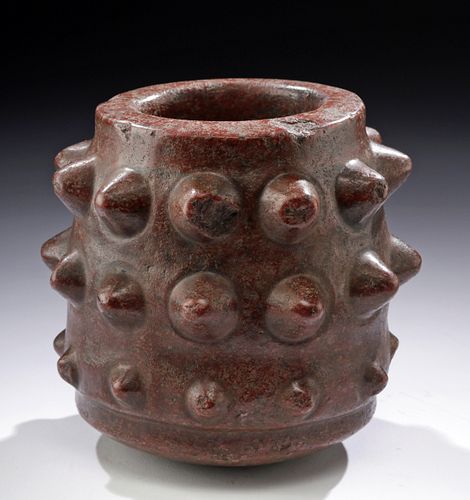Chavin Stone Jar w/ Cactus-Like Protrusions
Lot 115
About Seller
Artemis Fine Arts
686 S Taylor Ave, Ste 106
Louisville, CO 80027
United States
Selling antiquities, ancient and ethnographic art online since 1993, Artemis Gallery specializes in Classical Antiquities (Egyptian, Greek, Roman, Near Eastern), Asian, Pre-Columbian, African / Tribal / Oceanographic art. Our extensive inventory includes pottery, stone, metal, wood, glass and textil...Read more
Categories
Estimate:
$6,500 - $9,750
Absentee vs Live bid
Two ways to bid:
- Leave a max absentee bid and the platform will bid on your behalf up to your maximum bid during the live auction.
- Bid live during the auction and your bids will be submitted real-time to the auctioneer.
Bid Increments
| Price | Bid Increment |
|---|---|
| $0 | $25 |
| $300 | $50 |
| $1,000 | $100 |
| $2,000 | $250 |
| $5,000 | $500 |
| $10,000 | $1,000 |
| $20,000 | $2,500 |
| $50,000 | $5,000 |
| $100,000 | $10,000 |
| $200,000 | $20,000 |
About Auction
By Artemis Fine Arts
Oct 8, 2020
Set Reminder
2020-10-08 10:00:00
2020-10-08 10:00:00
America/New_York
Bidsquare
Bidsquare : Exceptional Antiquities, Asian, Ethnographic
https://www.bidsquare.com/auctions/artemis-gallery/exceptional-antiquities-asian-ethnographic-5796
Museum-worthy examples of Egyptian, Greek, Roman, Etruscan, Near Eastern, Far East / Asian, Pre-Columbian, African / Tribal,Oceanic, Native American, Spanish Colonial, Russian, Fossils, Ancient Jewelry, Fine Art, so much more! Artemis Fine Arts info@artemisfinearts.com
Museum-worthy examples of Egyptian, Greek, Roman, Etruscan, Near Eastern, Far East / Asian, Pre-Columbian, African / Tribal,Oceanic, Native American, Spanish Colonial, Russian, Fossils, Ancient Jewelry, Fine Art, so much more! Artemis Fine Arts info@artemisfinearts.com
- Lot Description
Pre-Columbian, North Coast Peru, Chavin culture, ca. 900 to 500 BCE. A stunning jar of a sizable form, hand-carved from speckled vermilion-hued stone with dark inclusions. The cylindrical body has a round but stable base, tall walls, a rounded rim with an incised groove, and a deep interior cavity. The exterior of the body is decorated with thirty-three conical protrusions - each representing a cactus needle - arranged into eleven columns. The style of this vessel probably represents the San Pedro cactus, whose branches contain a hallucinogenic substance that was likely utilized for rituals and making traditional medicines. Size: 6" W x 5.7" H (15.2 cm x 14.5 cm)
The Chavin civilization developed in the northern Andean highlands of Peru from 900 to 200 BCE in the Mosna Valley where the Huachecsa and Mosna rivers merge. The most famous archaeological ruin of the Chavin culture is Chavin de Huantar. Believed to have been built around 900 BCE, this religious center is now a UNESCO world heritage site.
Provenance: private southwestern Pennsylvania, USA collection; ex-Jose Arias collection, collected in the early 20th c and brought to Argentina by his grandfather, then to the US in the 1970s
All items legal to buy/sell under U.S. Statute covering cultural patrimony Code 2600, CHAPTER 14, and are guaranteed to be as described or your money back.
A Certificate of Authenticity will accompany all winning bids.
We ship worldwide and handle all shipping in-house for your convenience.
#150157Minor nicks to base, some conical protrusions, and rim, with light abrasions to base and body, and minor encrustations within basin, otherwise intact and very good. Nice earthen deposits and great surface smoothness throughout.Condition
- Shipping Info
-
All shipping is handled in-house for your convenience. Your invoice from Artemis Gallery will include shipping calculation instructions. If in doubt, please inquire BEFORE bidding for estimated shipping costs for individual items.
-
- Buyer's Premium



 EUR
EUR CAD
CAD AUD
AUD GBP
GBP MXN
MXN HKD
HKD CNY
CNY MYR
MYR SEK
SEK SGD
SGD CHF
CHF THB
THB















